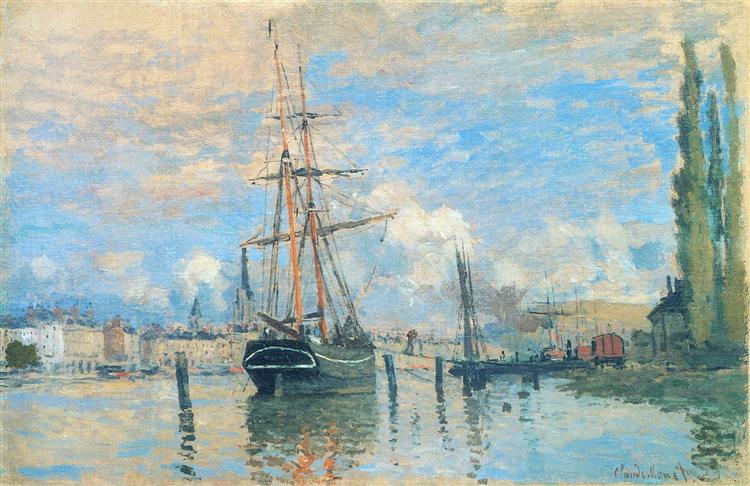תיאור
In The Seine at Rouen (1872), Claude Monet offers us an evocative interpretation of the river landscape, idiosyncratic to his Impressionist style which, in this period, was beginning to consolidate itself as a response to the pictorial tradition of the time. The work illustrates the famous River Seine at Rouen, a place that became a recurring theme in Monet's work, symbolizing not only the geography of northern France, but also a visual exploration of the light and atmosphere that surrounds it.
The composition is dominated by a soft, diaphanous play of color that reflects Monet's masterful ability to capture the nuances of light on the water. The surface of the river appears almost ethereal, where the blue hues of the water intertwine with flashes of white and green, suggesting the modulated transition of light on a cloudy afternoon. The technique of loose, rapid brushstrokes characteristic of Impressionism is evident in the way Monet caresses the surface of the canvas, creating a vibrant sense of movement in both the water and the breeze that seems to blow across the canvas.
To the left of the work, a group of boats can be seen floating peacefully, a choice that emphasizes the vitality of the river, even in its apparent calm. These boats, which vary in size, add a dimension of scale and human reference that dialogues with the vast aquatic landscape. However, there is no human figure that captures the central attention; instead, Monet chooses to highlight nature itself and its interaction with the structures in the environment. This approach allows the viewer to immerse themselves in the visual experience as well as the ephemeral beauty of the moment, a hallmark of the Impressionist movement.
The sky, a canvas of grey clouds interspersed with flashes of blue and white, reinforces the overall atmosphere of the painting. Monet succeeds in translating the quality of natural light into the landscape, making the colours seem to vibrate. This attention to lighting conditions is an essential feature of Monet's work and resonates with his later experiments in series of works where the same scene is depicted in different conditions of light and time.
In the context of art history, this work is not only an exemplar of the French natural environment, but also fits into the broader conversation of Impressionism, which sought to break away from academic conventions and offer a true representation of the visual experience of the world. Monet, along with his contemporaries such as Camille Pissarro and Pierre-Auguste Renoir, devoted himself to exploring changes in light and color, influencing the development of modern art.
"The Seine at Rouen" is more than just a depiction of a landscape; it is a meditation on light, movement and perception. Monet captures the essence of the moment, using his brush to translate the world around him into a visual language that continues to speak to subsequent generations. In contemplating this work, the viewer is invited to reflect on the transience of time and the ceaseless change of nature, fundamental pillars of this important artistic movement that, at the time, transformed the way we see and understand art.
KUADROS ©, a famous painting on your wall.
Hand-made oil painting reproductions, with the quality of professional artists and the distinctive seal of KUADROS ©.
Painting reproduction service with satisfaction guarantee. If you are not completely satisfied with the replica of your painting, we will refund 100% of your money.

